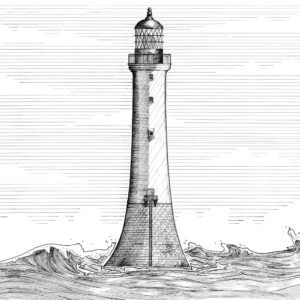The latest lighthouse to emerge from Ben Langworthy’s pen is Arbroath’s Bell Rock — the world’s oldest still-functioning sea-washed lighthouse, and stuff of devilish legend.

A voyage through the rough grey-blue waters of the North Sea is not to be undertaken lightly. This is a place where perils abound; where harsh winds combine with thick fog and shallow waters create strong, unpredictable currents. It is also a place of hidden dangers and cautionary tales.
Around 11 miles off the Arbroath coast there lies an infamous reef known as the Inchcape Rock. Visible only for a fleeting few hours at low tide each day, this jagged danger spends most of its life hidden just below the surface. Over the centuries many ships have been lost here. In fact it is estimated that by dawn of the 19th Century around six ships would be wrecked upon the rock each winter. Perhaps the most famous of these was the HMS York, which went down with all hands in 1804 — the tragedy of which further garnered support for the building of a lighthouse to mark this sandstone menace.
Bell Rock Lighthouse was first lit in 1810 and is now the oldest sea-washed lighthouse still in use to be found anywhere in the world. It was designed by Robert Stevenson who based his design on that of Smeaton’s tower off the coast of Plymouth. It is a testament to his engineering skill that after 200 years of being beaten by the harsh Scottish sea, this remote grey-white tower stands resolute. A beacon and a warning that had saved countless lives.
The lighthouse takes its name from the peculiarly named Bell Rock on top of which it sits. The origins of this second name for the Inchcape rock are a matter of legend — one immortalised in the ballad ‘The Inchcape Rock’, written by the poet Robert Southey in 1802.
The tale tells of the 14th century Abbot of Arbroath who installs a signal bell attached to a buoy anchored to the rock to warn mariners of the dangerous reef below. However the wicked Sir Ralph the Rover cuts the bouy adrift and casts the bell into sea, relishing the despair and destruction he will cause. By a twist of fate it is the selfsame pirate who finds himself wrecked upon the rock, and as his ship slips below the surging sea, he once again hears the sorrowful tolling of the bell from the deep, rung by the devil, the ringing summoning him to his watery tomb.
They hear no sound, the swell is strong,
Though the wind hath fallen they drift along;
Till the vessel strikes with a shivering shock,
“Oh Christ! It is the Inchcape Rock!”Sir Ralph the Rover tore his hair,
He curst himself in his despair;
The waves rush in on every side,
The ship is sinking beneath the tide.But even is his dying fear,
One dreadful sound could the Rover hear;
A sound as if with the Inchcape Bell,
The Devil below was ringing his knell.